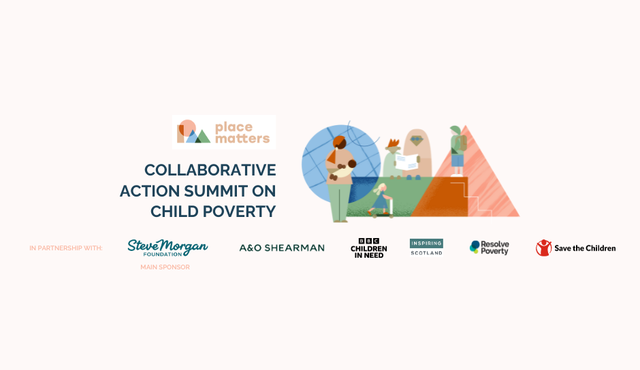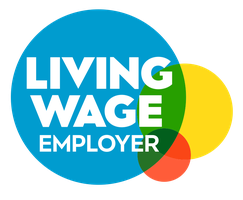Tackling child poverty with place-based communities

There were three overarching themes and challenges:
i) how might we enable more community agency to act on child poverty in places,
ii) how might we better support those communities through more radical forms of multi-sector collaboration, and
iii) how might we connect the levels of the system, including place, regional and national, so each can play its part more effectively.
There was a strong sense of the necessity for a bigger ambition for tackling child poverty that harnesses all the resources, experience and passion evident throughout the Summit. Whilst attendees were open and candid, sharing the challenges and barriers to working collaboratively, the mood was one of optimism about the opportunity to make a difference and many ideas and examples gave a sense of the untapped potential in UK communities. You can read more reflections from the day, on being bold, ambitious and brave, from Liz Weaver, and on ‘seeing like a place’ from James Plunkett.
Below we have picked out some of the themes and actions from the discussions on the day that particularly resonated with the Place Matters team and where we hope to follow-up.
More radical collaboration
Child poverty is everyone’s business – it’s not on the agenda, it is the agenda
A recurring theme from discussions on the day was the need to be bolder and more ambitious. We heard about the political leadership from the Scottish Government and North East Combined Authority to tackle child poverty as a galvanising mission across multiple policy areas.
We heard about the Investment Dialogue for Australia’s Children, which connects government, philanthropists, and stakeholders in a long-term programme for change. Equally, we heard about the importance of agency and trust for frontline teams who understand families and children best to be able to act in their interests, rather than being constrained in a risk-adverse system. We sensed that the constituent elements of bold and effective strategies to tackle child poverty are all out there. Still, we need to bring those elements together through more radical forms of collaboration and bold action. That needs investment into the tools and mechanisms for collaboration like data sharing agreements, common outcomes framework, collaboration governance and blended funding models as well as the commitment of leaders to prioritise and focus on child poverty as a central mission.
A 30-year ambition
No child gets a second childhood
Wicked problems, such as poverty, will not be solved in competitive 3-year funding cycles. This work needs a 30-year outlook supported by long-term, agile funding that encourages and rewards collaboration, harnesses and coordinates the considerable resources and expertise that exists in many communities and works at all the levels needed to bring about change. That means having strategic reach and influence, but also working at a scale that can deliver the ‘small’ wins so essential to build momentum and trust in the longer-term journey of change. It means being highly focused on investing in the levers for change that work and de-investing where necessary to align resources, priorities, and, crucially, the time of local leaders to create the change. Too many competing priorities dilute collective effort.
Leadership, agency and collaboration
create spaces where people with differences can hear from each other, building understanding and ‘seeing each other as humans’ not just roles
In genuine, place-based efforts, each sector has its role to play, but the challenge is how to create an environment for effective collaboration, including challenging how power is held in places and the bravery of public sector leaders to devolve power to communities. We heard from Mary Brennan from The Poverty Truth Commission of the neglected skills and knowledge that sit within communities, but how the onus sits with them to influence change in the system - the system doesn't usually take the time to come to find out what it can do.
As Liz Weaver points out in her recent blog following the Summit, place-based solutions are a daily practice in many of our communities. This work is not new or innovative, places have been offering solutions for families experiencing poverty for decades. We need to invest in creating local leaders from all sectors to share similar perspectives across sectors. Leaders with an appetite for change, who do not necessarily lead from the front, instead seek to inspire and enable others to create the change. Local people who took part in the Summit told us they don’t want or need to be empowered by others, they want agency nor permission to take action.
empowerment' is a problematic word; it's paternalistic
The language of poverty
Need to stop talking about poverty and Troubled Families! Need to engage and listen to families and destigmatise
Professionals working with vulnerable communities, talked about being tired of negative, stigmatising narratives about people and where they live. People in disadvantaged communities don’t see themselves as living in ‘poverty’, such is the profound impact that the stereotypes attached to the word can have. There was an agreement on the strength of taking an assets-based approach, focused on what works well, the strengths of a community, and being solution, not problem-focused. The language of poverty often implies that those who are forced to endure it are passive actors, when we know the power, strength and resilience of these communities to lead the change they want to see given the environment to enable this. . If we are to build a hopeful movement, we need a positive narrative that energises commitment.
Listening better
Deep listening’ is important but we also need to collectively act on this listening
Poverty is experienced very differently across and within communities and those who make policy and funding decisions need to find a way of connecting to communities to understand priorities and opportunities for change. Delegates from Canada discussed how the Canadian Government, at all levels, spent significant time listening to communities, putting what they heard into the public record so that communities could see how their perspectives are shaping policy decisions. Colleagues in the UK shared examples of how national and regional policy was being shaped through deep engagement, but it was felt this was not consistent across the UK in each level of Government and more humility was needed by those in power to be led by communities.
We are following up on these and other themes and actions that were of interest at the Summit. Please reach out if you would like to follow up on ideas or actions and we’ll be in touch.

